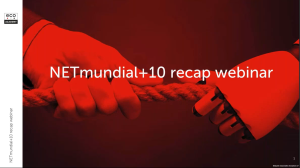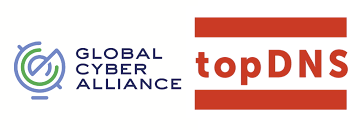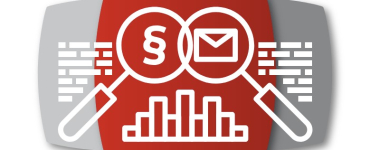In 2014, the global multistakeholder meeting NETmundial took place in response to global concerns about Internet governance, triggered by revelations about widespread Internet surveillance. The conference, convened by multiple stakeholders, set out to establish a comprehensive set of Internet governance principles promoting transparency, inclusivity, and accountability in digital policy processes.
A decade later, the NETmundial+10 meeting was held in April 2024 in São Paulo, Brazil. It aimed to assess the progress since and renewed the multi-stakeholder commitment to evolving Internet governance landscapes. This second global multi-stakeholder meeting not only served as a retrospective but also as a forward-looking platform, proposing pathways for future governance mechanisms. In May 2024, eco – Association of the Internet Industry hosted a webinar with speakers from different stakeholder groups of the High-Level Executive Committee (HLEC), recapping the highlights and key takeaways of the event.
The NETmundial multi-stakeholder approach
NETmundial began by establishing a high-level committee, a practice mirrored in the subsequent 2024 meeting. The original process involved online consultations to discuss a draft document, followed by a formal meeting where negotiations took place over two days. This approach was inclusive, bringing together governments, civil society, the technical and private sectors, and academia to agree on the documents. As the HLEC Co-Chair, Jeanette Hofmann of the WZB Berlin Social Science Center, highlighted, the governments endorsed the document, providing it with an almost official status – a novel development in Internet governance.
NETmundial+10 adopted a similar but expanded process. In the autumn of 2023, it initiated a scoping group to explore the feasibility and framework of such an event. In early 2024, CGI.br, the Brazilian organization responsible for the inaugural meeting, issued a joint statement outlining the objectives and structure of the upcoming one. This included refining the NETmundial principles and devising practical proposals and benchmarks to enhance multi-stakeholder approaches.
In March 2024, a public consultation gathered broader input, followed by the release of a preliminary outcome document shortly before the meeting. This approach aimed to build on previous successes while adapting and refining strategies to address new governance challenges.
Intergovernmental Organizations in Internet Governance
Ana Neves, CSTD – Commission on Science and Technology for Development, shared her perspective on how intergovernmental organizations influence and are influenced by global Internet governance trends. One essential pillar of NETmundial is the High-Level Executive Committee (HLEC), of which she is a member. It was formed through discussions by CGI.br during meetings such as the IGF in Kyoto and ICANN. They had bilateral meetings to gauge community interest in reevaluating the role of different stakeholders in global Internet governance.
The focus group was established to contemplate the structural setup of the NETmundial+10 event. Members debated the processes and meeting framing. Following this, the group recommended individuals for the high-level executive committee, aiming to represent diverse stakeholder groups and geographical regions.
The diverse committee was formed to ensure balanced representation and was tasked with operating within a tight timeframe to guide the preparations for the NETmundial+10 meeting. Ana highlighted the committee’s critical role in addressing logistical and thematic needs, ensuring that the meeting could address various stakeholder perspectives and lead to meaningful outcomes.
Collaboration and Consensus: The High-Level Executive Committee’s Role in Shaping NETmundial+10 Outcomes
Bruna Martins dos Santos of Digital Action, representing the civil society perspective, provided insights into the dynamics and workings of the High-Level Executive Committee (HLEC). She particularly valued that all committee members shared a strong desire to produce meaningful outcomes. Their approach was highly collaborative, with a focus on collective evaluation of the issues. This spirit was pivotal in aligning the diverse perspectives towards a common goal. Each stakeholder group consulted their respective communities, facilitating a wide range of views in the committee’s discussions, contributing to a more inclusive and representative decision-making process. They effectively worked towards common goals through a structured and participatory approach, reinforcing the multi-stakeholder model and enhancing the committee’s recommendations’ legitimacy and applicability in Internet governance.
The NETmundial+10 Multistakeholder Statement is the final document produced by the HLEC, a testament to the collaborative efforts of the committee. It aims to encapsulate the discussions and consensus reached on key issues, positioning it as a valuable tool for future governance dialogues.
Internet governance strategies must address the dynamic challenges of the digital world
Lise Fuhr of the European Telecommunications Network Operators Association (ETNO), representing the private sector perspective, emphasized the ongoing need for collaboration and innovation in Internet governance to address digital challenges. She underscored the necessity for continuous evaluation and adaptation of governance models to keep them relevant and effective.
She examined the relationship between NETmundial and other Internet governance forums and processes, as well as the implications for the future of Internet governance. While there is no formal relationship between NETmundial and the IGF, Lise pointed out significant links between the two. For example, the participation of key individuals in both forums indicates an interest in maintaining connections.
As Lise put it, IGF doesn’t have a monopoly on the multi-stakeholder model. Recommendations from NETmundial can be used by the IGF and other Internet governance bodies to improve their processes. She advocated using the NETmundial+10 outcomes to push for more multi-stakeholder inclusion in other global governance processes, like the Global Digital Compact. She echoed Ana Neve’s hope that these efforts would expand the implementation and impact of multi-stakeholder models beyond traditional Internet governance forums.
Lise noted a shift from solely Internet-focused discussions to broader digital policy and processes. This reflects the evolving nature of the Internet and digital technologies, requiring a more inclusive approach to governance.
Rapid technological change requires adaptive governance models
Representing the technical community, Jordan Carter from auDA (.au Domain Administration Ltd) focused on how technical advancements and challenges impact governance and what future developments might mean for the multi-stakeholder model.
Jordan highlighted the evolving role of technical standards and infrastructure in Internet governance. He focused on how rapid technological changes, such as the adoption of new Internet protocols or security standards, necessitate adaptive and forward-looking governance models. Jordan discussed the future challenges and opportunities facing Internet governance, also in relation to emerging technologies such as artificial intelligence and quantum computing.
He also speculated on future developments’ impact on the multi-stakeholder model, suggesting that technology must drive the evolution of governing frameworks and processes. He stressed the importance of effectively linking Internet management’s technical aspects with policy discussions, understanding the technical implications of policy decisions, and ensuring policymakers are informed about the technological context of their decisions.
Jordan advocated for inclusive technical governance involving stakeholders from technical, governmental, and civil sectors. He argued that a collaborative approach ensures more robust and widely accepted structures.
The multi-stakeholder model
In the recap webinar, Wolfgang Kleinwächter, an expert on Internet governance and member of the NETmundial Advisory Group within the HLEC, proposed developing a system of measurement to evaluate digital processes, which could lead to a “naming and shaming” approach for governments that only pay lip service to multi-stakeholder engagement. He stressed the importance of real involvement over superficial engagement. He also suggested encouraging the academic community to research the implementation and impacts of NETmundial guidelines to evaluate the multi-stakeholder processes and identify areas for improvement.
Ana Neves stressed the variability in governmental understanding and acceptance of the multi-stakeholder model, particularly in contexts where governments may not be democratically oriented or familiar with such collaborative governance frameworks. Ana suggested that the multi-stakeholder outputs from NETmundial+10 could promote broader acceptance and implementation of these models. She believes the NETmundial process could serve as a model in Internet governance and other sectors to enhance policy-making and implementation processes.
Jeanette Hofmann suggested creating an institutional repository to document experiences, adaptations, and modifications to the multi-stakeholder guidelines. This would serve as a resource for ongoing education and advocacy and enable continuous improvement and adaptation.
Recognizing the dynamic nature of digital technology and policy, Lise Fuhr advocated for periodic reassessments of the multi-stakeholder processes, suggesting a review every ten years to keep the governance models relevant and effective in addressing technological advances and changing geopolitical landscapes.
Bruna Martins dos Santos highlighted the role of the Internet Governance Forum (IGF) as a potential custodian for the NETmundial outcomes. She suggested that integrating them into the IGF’s work could enhance their visibility and impact. She also mentioned that the guidelines could influence discussions in other international forums and processes, like the Global Digital Compact.
Ana Neves stressed the importance and utility of extending multi-stakeholder governance beyond the Internet to other areas such as environmental policy, human rights, and international trade. This broader application could instil democratic and inclusive decision-making processes in various global governance arenas.
The potential of multi-stakeholder processes
The continuous evolution of technology demands a proactive approach to governance. Embracing multi-stakeholder collaboration and reassessing models allows organizations to navigate digital policy and innovation. The call for enhanced inclusivity and accountability resonates across various sectors, emphasizing the need for robust frameworks that promote transparency and participation. As global Internet governance evolves, maintaining a dynamic and responsive stance is imperative for addressing emerging challenges effectively.
To learn more about NETmundial and download the multi-stakeholder statement document, visit https://netmundial.br/.
On 4 June, eco – Association of the Internet Industry hosted a a NETmundial+10 recap webinar to summarise and discuss selected topics from the Global Stakeholder Meeting in São Paulo in April 2024. The recording is now available in the members+ area for eco members.




